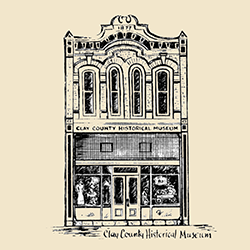 The Clay County Museum building dates from about the mid-1850s, once thought to be as a pharmacy. However, it apparently began life as a dry goods store. From an issue of the Liberty Weekly Tribune, dated January 14, 1881, an article on “Liberty in 1846-7” stated “In 1847, Mr. N.H. Summers brought on a fine stock of goods, and a few days after opening, knocked the head out of a keg of black gun powder, took his seat upon it and touched it off. Strange to say, that it did not instantly kill him – he lived from daylight in the morning until about 9 o’clock in the night. Mr. James Fritzlen bought the late Mr. Summers stock and continued the business. It was stated that; “Mr. Summers was a noble young man.” The article also mentioned Mr. Summers had been a clerk for Samuel & Gilmer, a dry goods merchant. Mr. Fritzlen passed away in 1849 but the building and business continued.
The Clay County Museum building dates from about the mid-1850s, once thought to be as a pharmacy. However, it apparently began life as a dry goods store. From an issue of the Liberty Weekly Tribune, dated January 14, 1881, an article on “Liberty in 1846-7” stated “In 1847, Mr. N.H. Summers brought on a fine stock of goods, and a few days after opening, knocked the head out of a keg of black gun powder, took his seat upon it and touched it off. Strange to say, that it did not instantly kill him – he lived from daylight in the morning until about 9 o’clock in the night. Mr. James Fritzlen bought the late Mr. Summers stock and continued the business. It was stated that; “Mr. Summers was a noble young man.” The article also mentioned Mr. Summers had been a clerk for Samuel & Gilmer, a dry goods merchant. Mr. Fritzlen passed away in 1849 but the building and business continued.
Another Liberty Tribune article mentioned on August 17, 1877, that “experienced druggist, Dan Hughes has moved into his new drugstore building and now has one of the most stylish drugstores “in the West”. While another article dated January 8, 1886, stated that “Dan Hughes was a successful druggist at his present location, for nearly twenty years – first as a prescription-clerk, with his predecessor, William A Hall, and afterward as the business’ sole proprietor”. This suggests the building, or the lot that once housed the dry goods store of Mr. Summers, was used as a pharmacy prior to the construction or reconstruction of today’s existing building.
Added to this mix is that of the State Historical Society of Missouri Research Center records on the Hughes/Simmons Drug Store gives the building’s history as Daniel Hughes, Jr., began working for S.W. Warren in his drug store in Liberty, Missouri in 1865 and became a partner in 1870. In 1872 he purchased the business. He carried, a large and well selected stock of goods in his line… and “the business prospered“.
In 1877, Mr. Hughes remodeled his old building into the Italianate style it has today. Joseph C. Simmons bought the store from Hughes in 1887 and operated it until his death in 1945, some 58 years later. Many of the apothecary bottles and the equipment on display were used by these two pharmacists.
[Notice the Simmons name in the doorway-tile at the entrance to the Museum]
The building was later purchased by Dr. William H. Goodson M.D. who had practiced on the upper floor since 1907. He continued to practice there until his death in 1963. The Doctor had his own druggist, Clarence Ferril, installed on the first floor, continuing the tradition of the drug store in the building. Dr. Goodson would communicate with Mr. Ferril via an early intercom phone, which still graces the wall in the doctor’s office of the museum. All manner of bottles and boxes of medicines are also on display that date as far back as Mr. Hughes ownership.
Occasionally, visitors will tour the museum and recount seeing Dr. Goodson as a patient. Each has had only the highest praise for him. Visitors see the doctor’s office and the equipment he used, much of which he had fashioned of his own design. The building houses many artifacts along with the spirit of the drugstore and doctor’s office it once was.
A variety of exhibits and ever-changing displays acquaints visitors with Clay County’s history. The renovated lower-level features early cottage industries, farming equipment, tools, a vintage kitchen, a “touch table” and 1900s Boy Scout equipment. The main floor is divided by a glass partition with vintage display cases filled with fine china, toys, railroad artifacts and apothecary paraphernalia. Behind the partition the visitor will find letters by the Jesse James family, Civil War, World War I and World War II items, antiques quilts and Native American artifacts.
The upper-level floor includes Dr. Goodson’s office, as set up by his son, also Dr. Goodson, along with 3 rooms of antique furniture, displays of the county courthouse(s), vintage sewing machines as well as other bits and pieces of Clay County’s past.
Chery Carr Holtman, curator, Clay County Museum
This Mortar and Pestle is a reminder of the “Tools of the Trade” for a pharmacist (even still today).

